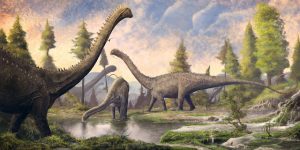The Other Side of the Pass
by Raton Museum Staff
RATON — Once upon a time in the deep dark recesses of time, a cloud of dust appeared because a super massive star exploded. This is not a nursery rhyme, it is how our home planet, Earth, came into existence. This, according to scientists, occurred about 4.4 billion years ago. Over time, this cloud coalesced into a star named Sol. In the next billion years, the various planets were formed. In addition, the new planet acquired water and land.
Earth’s land is merely a crust that is not a solid mass. It is a series of tectonic plates, about seven or eight plus many minor plates. The plates were created by magma from the core, which flowed to the surface and cooled on contact with the colder atmosphere. Over time, these lava fields (it’s magma underground and lava above ground) became thicker and thicker, eventually forming plates that range in thickness from 32 to over 120 miles thick. They are rigid, but still slowly creep across the mantle, which is super-heated. This creep is so slow that the human eye cannot view it, but scientists can measure it over time. This creep is the reason for land masses enlarging and breaking apart through the millenia— the continents we know today have migrated back and forth across the globe, breaking apart and coming back together, rising and falling as the magma beneath them moves.
The movement of the plates caused the formation of the Western Interior Seaway, which existed from one hundred million years ago to sixty-six million years ago. At its largest extent, the seaway was over 600 miles wide and 2,500 feet deep. It connected the Arctic Ocean to the Gulf of Mexico. The ocean would have included a large area in what is now the American West. This would be from about Montana east to the Dakotas on down, which would have included 90% of New Mexico.
 Yes, this means that Raton would have been underwater for over thirty million years. Eventually the water receded to reveal the land underneath.
Yes, this means that Raton would have been underwater for over thirty million years. Eventually the water receded to reveal the land underneath.
This movement of the Earth’s crust has created several super continents over time. These continents come into being and over many millions of years, before eventually being pulled apart once more. The last super continent was known as Pangaea. A massive conglomeration that included all of Earth’s land masses, Pangaea was created approximately 335 million years ago and started its breakup approximately two hundred million years ago during the Triassic and Jurassic Periods. These periods are when the dinosaurs roamed Earth. The Triassic is known for the beginning of the dinosaur age where the creatures were smaller than their later cousins of the Jurassic.
The Jurassic is well known for gigantic dinosaurs which roamed the earth. Some famous New Mexican dinos include the Allosaurus, Diplodocus, and Stegosaurus. Sorry movie fans, T-Rex was actually a Cretaceous dino, not Jurassic.
To support these creatures, the atmosphere was vastly different from what it is today. Just what was the atmosphere like? It was akin to the rain forest on Earth today except on a much more massive scale. Rainforests have a humid, hot atmosphere with myriads of trees and plants, plus water. According to Wikipedia, “Rainforests are characterized by a closed and continuous tree canopy, high humidity, the presence of moisture-dependent vegetation, a moist layer of leaf litter, the presence of epiphytes and lianas and the absence of wildfire. The largest areas of rainforest are tropical or temperate rainforests, but other vegetation associations including subtropical rainforest, littoral rainforest, cloud forest, and even dry rainforest.” The canopy of a typical rainforest is 98 to 148 feet tall. The canopy is not a man made canopy, just merely the treetops of the largest trees. It prevents the rain and the sun from directly hitting the forest floor.
Everything during the Jurassic was immense. Since biomatter is not typically found in fossils, one must imagine what those rainforests were like. Today’s rainforests are filled with giant trees which have leaves that are also large. The Raton Museum has a fossil of a tree leaf that is approximately two feet wide. These trees and plants were everywhere. They had to be, to support the huge beasts who roamed the earth.
To give you an idea of their size, consider the sauropods. Among the largest creatures who’ve ever roamed the earth, members of this family of dionsaurs, who were all herbivores, were typically 60-102 feet tall, fifty feet in length, and weighed seventy-nine tons. They had long necks and tails, and small heads. They moved in herds to help protect each other from the meat eating predators. To give a size comparison, a giraffe is 14-19 feet in height and weighs approximately one ton. Blue whales are on average 90 feet long, so picture putting a blue whale on its tail and you’ll get an idea of how tall a sauropod would be.
What ended this era? Approximately sixty-six million years ago, an asteroid six to nine miles in diameter plowed into Earth near the town of Chicxulub, in the Yucatan Peninsula in Mexico. This impact created the Cretaceous-Paleogene (K-P, formally known as the Cretaceous-Tertiary or K-T) boundary which marks the time when most dinosaurs were killed off and became extinct. The layer is worldwide and can be seen in Raton about eight inches beneath the coal layer. The area can be viewed on Goat Hill behind a locked gate; however, you can see it by first visiting Raton City Hall to acquire the lock combination.
What all this means is that once upon a time, Raton was home to an inland sea and a rain forest. The first citizens of Raton were not American Indians, but were huge creatures and plants from the Jurassic era.




